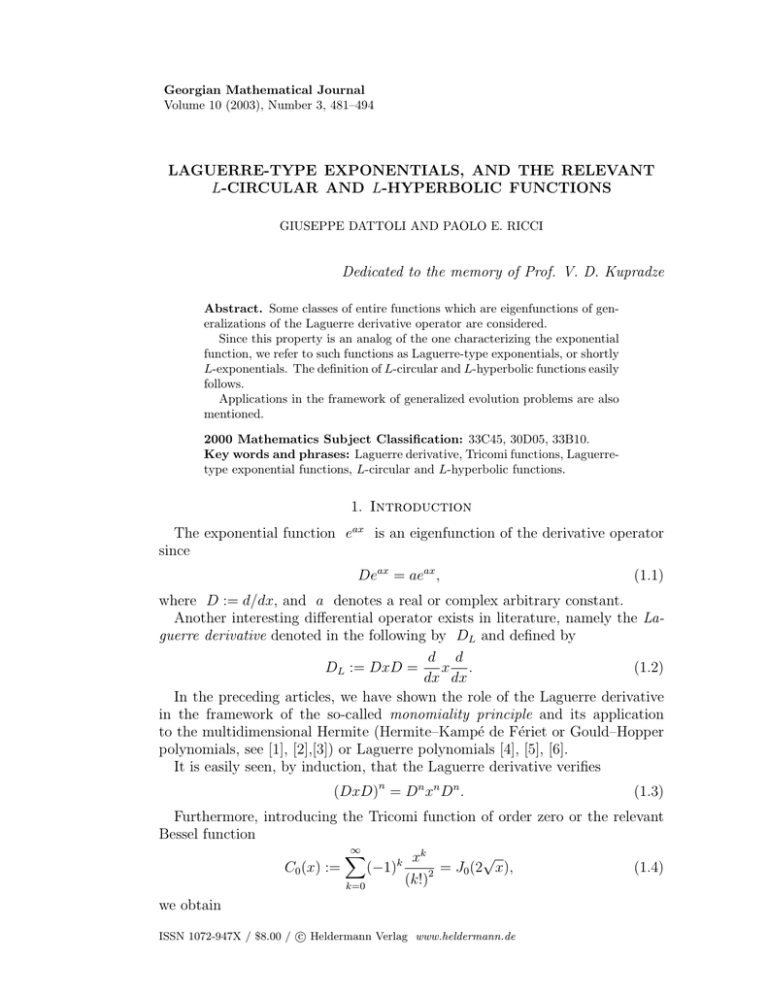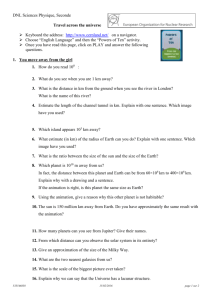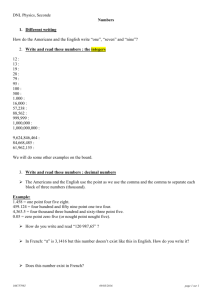LAGUERRE-TYPE EXPONENTIALS, AND THE RELEVANT L
advertisement

Georgian Mathematical Journal
Volume 10 (2003), Number 3, 481–494
LAGUERRE-TYPE EXPONENTIALS, AND THE RELEVANT
L-CIRCULAR AND L-HYPERBOLIC FUNCTIONS
GIUSEPPE DATTOLI AND PAOLO E. RICCI
Dedicated to the memory of Prof. V. D. Kupradze
Abstract. Some classes of entire functions which are eigenfunctions of generalizations of the Laguerre derivative operator are considered.
Since this property is an analog of the one characterizing the exponential
function, we refer to such functions as Laguerre-type exponentials, or shortly
L-exponentials. The definition of L-circular and L-hyperbolic functions easily
follows.
Applications in the framework of generalized evolution problems are also
mentioned.
2000 Mathematics Subject Classification: 33C45, 30D05, 33B10.
Key words and phrases: Laguerre derivative, Tricomi functions, Laguerretype exponential functions, L-circular and L-hyperbolic functions.
1. Introduction
The exponential function eax is an eigenfunction of the derivative operator
since
Deax = aeax ,
(1.1)
where D := d/dx, and a denotes a real or complex arbitrary constant.
Another interesting differential operator exists in literature, namely the Laguerre derivative denoted in the following by DL and defined by
d d
DL := DxD =
x .
(1.2)
dx dx
In the preceding articles, we have shown the role of the Laguerre derivative
in the framework of the so-called monomiality principle and its application
to the multidimensional Hermite (Hermite–Kampé de Fériet or Gould–Hopper
polynomials, see [1], [2],[3]) or Laguerre polynomials [4], [5], [6].
It is easily seen, by induction, that the Laguerre derivative verifies
(DxD)n = Dn xn Dn .
(1.3)
Furthermore, introducing the Tricomi function of order zero or the relevant
Bessel function
∞
X
√
xk
C0 (x) :=
(−1)k
(1.4)
2 = J0 (2 x),
(k!)
k=0
we obtain
c Heldermann Verlag www.heldermann.de
ISSN 1072-947X / $8.00 / °
482
GIUSEPPE DATTOLI AND PAOLO E. RICCI
Theorem 1.1. The function
e1 (ax) := C0 (−ax)
(1.5)
is an eigenfunction of the Laguerre derivative operator, i.e.
DL e1 (ax) = ae1 (ax).
(1.6)
DL = D + xD2 ,
(1.7)
Proof. Note that
and consequently
∞
k
¡
¢ X
2
k x
DL e1 (ax) = D + xD
a
(k!)2
k=0
=
∞
X
(1.8)
∞
(k + k(k − 1)) ak
k=1
∞
X
=a
k=0
ak
k−1
X
xk−1
2 k x
=
k
a
(k!)2
(k!)2
k=1
xk
= ae1 (ax).
(k!)2
¤
Note that the preceding conclusion depends on the coefficients of the combination expressing the Laguerre derivative DL in terms of D, and xD, so
that it turns out the identity (k + k(k − 1)) = k 2 .
In the following we will show that the above technique can be iterated, producing Laguerre classes of exponential-type functions called L-exponentials and
the relevant L-circular, L-hyperbolic, L-Gaussian functions.
Further extensions are given in the concluding section, and applications to
the solution of generalized evolution problems is touched on.
2. Generalizations of the Laguerre Derivative and
L-Exponential Functions
In this section, we generalize the Laguerre derivative and define the relevant
L-exponential functions.
We start by considering the operator
¡
¢
D2L := DxDxD = D xD + x2 D2 = D + 3xD2 + x2 D3 ,
(2.1)
and the function
∞
X
xk
e2 (x) :=
.
(k!)3
k=0
(2.2)
The following theorem holds true:
Theorem 2.1. The function e2 (ax) is an eigenfunction of the operator
D2L , i.e.
D2L e2 (ax) = ae2 (ax)
(2.3)
LAGUERRE-TYPE EXPONENTIALS
483
Proof. Note that
¡
2
2
D2L e2 (ax) = D + 3xD + x D
3
∞
¢ X
ak
k=0
∞
X
xk
(k!)3
∞
k−1
X
xk−1
3 k x
=
(k + 3k(k − 1) + k(k − 1)(k − 2)) a
=
k
a
(k!)3
(k!)3
k=1
k=1
=a
∞
X
k=0
k
ak
xk
= ae2 (ax).
(k!)3
(2.4)
This completes the proof.
¤
Even in this case, the conclusion depends on the identity k + 3k(k − 1) +
k(k − 1)(k − 2) = k 3 so that it can be recognized that the coefficients of the
combination expressing the 2L-derivative D2L in terms of D, xD2 , and x2 D3
are the Stirling numbers of second kind, S(3, 1), S(3, 2), S(3, 3), (see [7], and
[8], p. 835 for an extended table).
We can consequently extend the above results as follows.
Considering the operator
¡
¢
D(n−1)L := Dx · · · DxDxD = D xD + x2 D2 + · · · + xn−1 Dn−1
= S(n, 1)D + S(n, 2)xD2 + · · · + S(n, n)xn−1 Dn
(2.5)
and the function
en (x) :=
∞
X
k=0
xk
,
(k!)n+1
(2.6)
we can state the following theorem:
Theorem 2.2. The function en (ax) is an eigenfunction of the operator
DnL , i.e.
DnL en (ax) = aen (ax).
(2.7)
Proof. Proceeding by induction, i.e. assuming equation (2.5) to be true, and
recalling the above remarks, it is sufficient to prove that the coefficients of the
combination expressing the nL-derivative DnL in terms of D, xD2 , . . . , and
xn Dn+1 , verify the same induction property as the Stirling numbers of second
kind, namely (see [7]):
S(n + 1, h) = S(n, h − 1) + hS(n, h).
This is clearly true since, considering in the equation
¢
¡
DnL := D S(n, 1)xD + S(n, 2)x2 D2 + · · · + S(n, n)xn Dn ,
the general terms, i.e.
¡
¢
D S(n, h − 1)xh−1 Dh−1 + S(n, h)xh Dh ,
(2.8)
(2.9)
(2.10)
484
GIUSEPPE DATTOLI AND PAOLO E. RICCI
we find
(h − 1)S(n, h − 1)xh−2 Dh−1 + S(n, h − 1)xh−1 Dh
+ hS(n, h)xh−1 Dh + S(n, h)xh Dh+1
so that the coefficient of xh−1 Dh is given by S(n, h − 1) + hS(n, h) and must
coincide with S(n + 1, h) and then recursion (2.8) holds true.
¤
Remark 2.1. The above results show that, for every positive integer n, we
can define a Laguerre-exponential function, satisfying an eigenfunction property,
which is an analog of the elementary property (1.1) of the exponential. This
P
xk
function, denoted by en (x) := ∞
k=0 (k!)n+1 , reduces to the exponential function
when n = 0 so that we can set by definition:
e0 (x) := ex ,
D0L := D.
Obviously, D1L := DL .
For this reason we will refer to such functions as L-exponential functions or,
shortly, L-exponentials.
Examples of the above functions are given in Fig. 1.
30
4
20
3
10
2
-100
-80
-60
-40
-20
1
-10
-40
-30
-20
-10
-20
25
-150 -125 -100
-75
-50
-25
-25
-50
-75
-100
-125
-150
Fig. 1
The above definitions allow us to introduce an extension of the Gauss function
−x2
e
by means of
Definition 2.1. The L-Gaussian functions are given by the entire even
functions
∞
X
x2k
2
e1 (−x ) =
,
(2.11)
(−1)k
2
(k!)
k=0
LAGUERRE-TYPE EXPONENTIALS
485
and, in general,
∞
X
x2k
en (−x ) =
(−1)k
.
n+1
(k!)
k=0
2
(2.12)
Examples of the above functions are given in Fig. 2.
1
-10
1
0.8
0.8
0.6
0.6
0.4
0.4
0.2
0.2
-5
5
-20
10
-10
10
-0.2
-0.2
-0.4
-0.4
20
20
-10
-5
5
10
-20
-40
-60
Fig. 2
3. L-Circular and L-Hyperbolic Functions
Write the 1L-exponential as follows:
∞
X
xk
e1 (ix) =
(i)k
(k!)2
k=0
∞
X
=
(−1)h
h=0
(3.1)
∞
X
x2h+1
x2h
h
+
i
(−1)
.
((2h)!)2
((2h + 1)!)2
h=0
Then we can formulate the definition
Definition 3.1. The 1L-circular functions are given by
cos1 (x) := < (e1 (ix)) = E (e1 (ix)) =
∞
X
h=0
(−1)h
x2h
,
((2h)!)2
(3.2)
∞
X
1
x2h+1
(−1)h
,
sin1 (x) := = (e1 (ix)) = O (e1 (ix)) =
2
i
((2h
+
1)!)
h=0
(3.3)
486
GIUSEPPE DATTOLI AND PAOLO E. RICCI
where E(f ) or O(f ) are the even part or the odd part of f .
Obviously,
e1 (ix) = cos1 (x) + i sin1 (x),
e1 (−ix) = cos1 (x) − i sin1 (x),
so that the Euler-type formulas
e1 (ix) − e1 (−ix)
e1 (ix) + e1 (−ix)
cos1 (x) =
,
sin1 (x) =
2
2i
hold true.
Recalling equation (1.3), we find the following result:
(3.4)
(3.5)
Theorem 3.1. The 1L-circular functions (3.2), (3.3) are solutions of the
differential equation
¡
¢
(3.6)
DL2 v + v = D2 x2 D2 v + v = 0.
Proof. Equation (3.6) is an easy consequence of Theorem 1.1, since
DL2 e1 (ix) = DL (ie1 (ix)) = −e1 (ix),
(3.7)
DL2 (cos1 (x) + i sin1 (x)) = − cos1 (x) − i sin1 (x).
(3.8)
so that
Then separating the real from the imaginary part in the above equation, the
proclaimed result follows.
¤
Write now the nL-exponential in the form
∞
X
xk
k
(i)
en (ix) =
(k!)n+1
k=0
=
∞
X
(−1)h
h=0
(3.9)
∞
X
x2h
x2h+1
h
(−1)
+
i
.
n+1
((2h)!)n+1
((2h
+
1)!)
h=0
Then we can formulate the definition
Definition 3.2. The nL-circular functions are given by
∞
X
x2h
cosn (x) := < (en (ix)) = E (en (ix)) =
(−1)h
,
n+1
((2h)!)
h=0
(3.10)
∞
X
1
x2h+1
sinn (x) := = (en (ix)) = O (en (ix)) =
(−1)h
.
n+1
i
((2h
+
1)!)
h=0
(3.11)
Obviously,
en (ix) = cosn (x) + i sinn (x),
en (−ix) = cosn (x) − i sinn (x)
(3.12)
so that we find again the Euler-type formulas:
en (ix) − en (−ix)
en (ix) + en (−ix)
,
sinn (x) =
.
(3.13)
cosn (x) =
2
2i
The same method used in Theorem 3.1 yields the more general result
LAGUERRE-TYPE EXPONENTIALS
487
Theorem 3.2. The nL-circular functions (3.10), (3.11) are solutions of the
differential equation
2
DnL
v + v = 0.
and satisfy the conditions
cosn (0) = 1,
sinn (0) = 0.
Then, using the same proof as in Theorem 2.2, we obtain
Theorem 3.3. The nL-circular functions satisfy
DnL cosn (x) = − sinn (x),
DnL sinn (x) = cosn (x).
(3.14)
Examples of the above functions are given in Fig. 3.
-40
-20
20
40
60
-10
-20
40
-30
20
-40
-20
-10
10
-50
20
600
20
400
200
-10
-5
5
10
-20
-75
-50
-25
25
50
75
-200
-40
-400
-60
-600
Fig. 3
We consider now the L-hyperbolic functions.
Definition 3.3. The nL-circular functions are given by
coshn (x) := < (en (x)) = E (en (x)) =
∞
X
x2h
,
((2h)!)n+1
(3.15)
x2h+1
.
((2h + 1)!)n+1
(3.16)
h=0
sinhn (x) := = (en (x)) = O (en (x)) =
∞
X
h=0
Obviously,
en (x) = cosn (x) + sinn (x),
en (−x) = cosn (x) − sinn (x)
(3.17)
488
GIUSEPPE DATTOLI AND PAOLO E. RICCI
so that we find again the Euler-type formulas:
en (x) + en (−x)
,
2
Furthermore, we have
cosn (x) =
sinn (x) =
en (x) − en (ix)
.
2
(3.18)
Theorem 3.4. The nL-hyperbolic functions (3.15), (3.16) are solutions of
the differential equation
2
w − w = 0,
DnL
(3.19)
and satisfy the conditions
coshn (0) = 1,
sinhn (0) = 0.
Theorem 3.5. The nL-hyperbolic functions satisfy
DnL coshn (x) = sinhn (x),
DnL sinhn (x) = coshn (x).
(3.20)
We omit graphics of the L-hyperbolic functions, whose shapes are similar to
those of ordinary hyperbolic functions.
3.1. Pseudo-L-circular and pseudo-L-hyperbolic functions. According
to the results stated in [9], [10] it is easy to find the functions decomposing the
L-exponentials with respect to the cyclic group of a given (integral) order r.
The relevant functions are denoted by [10]
Π[r,k] en (x) :=
∞
X
h=0
xrh+k
,
((rh + k)!)n+1
(k = 0, 1, . . . , r − 1),
(3.21)
and called pseudo-nL-hyperbolic functions of order r, while the pseudo-nLcircular functions of order r are defined by the position
∞
X
xrh+k
−k
σ0 Π[r,k] en (σ0 x) =
(−1)h
, (k = 0, 1, . . . , r − 1),
(3.22)
((rh + k)!)n+1
h=0
where σ0 denotes any complex r-th root of −1.
The following statement is valid.
Theorem 3.6. The pseudo-nL-circular functions of order r, (3.22) are
solutions of the differential equation
r
DnL
w + w = 0.
(3.23)
The pseudo-nL-hyperbolic functions of order r, (3.21) are solutions of the
differential equation
r
DnL
w − w = 0.
(3.24)
Remark 3.1. Note that equation (1.3) can be easily generalized as follows:
r
DnL
= (DxDx · · · DxD)r = Dr xr Dr xr · · · Dr xr Dr .
|
{z
}
(n+1) Derivatives
LAGUERRE-TYPE EXPONENTIALS
489
4. Consideration of the Above Results, and Further Properties
We prove the following
Theorem 4.1. The only polynomial solutions of the differential equation
DnL p = 0 are given by constants.
Proof. Note that DL p(x) = D (xD p(x)) = 0 implies xD p(x) = constant
and consequently p(x) = c1 + c2 log x, ch = constants (h = 1, 2) so that
the unique polynomial solution is a constant.
Furthermore, D2L p(x) =
DL xD p(x) = 0R implies xD p(x) = c1 + c2 log x so that D p(x) =
c1 + c2 log x + c3 logx x dx, and the unique polynomial solution is again a constant. Proceeding by induction, we find that DnL p(x) = D(n−1)L xD p(x) = 0
implies that xD p(x) is a linear combination of a set of functions obtained
by adding to the preceding set the primitive of each function divided by x.
In any case, the only polynomial solution derived in such a way is always a
constant.
¤
It was previously noted (see, e.g., [5]) that, considering in the space of polynomial functions the correspondence
D → DL ,
x· → Dx−1 ,
(4.1)
where
Dx−n (1) :=
xn
,
n!
(4.2)
a differential isomorphism is determined.
In such an isomorphism, the exponential function is transformed into the
(1)
function e1 (x), the Hermite polynomials Hn (x, y) := (x − y)n become the
Pn (−1)r yn−r xr
Laguerre polynomials Ln (x, y) := n! r=0 (n−r)!(r!)2 and the monomiality
principle ensures that all the relations proved in the initial polynomial space
still hold after performing the substitutions stated in equations (4.1).
Note that an iterative application of equations (4.1) to the exponential function gives subsequently functions e1 (x), e2 (x), e3 (x), . . . , and so on.
Accordingly, the derivative operator is transformed into
DL = DxD,
D2L = DL Dx−1 DL ,
D3L = DL Dx−1 DL Dx−1 DL ,
(4.3)
and so on.
Thus we can conclude that the L-exponentials (and the relevant L-circular
and L-hyperbolic functions) are determined by an iterative application of the
above mentioned-differential isomorphism.
This gives an explanation of the above results, since the subsequent derivatives are transformed into the powers of the Laguerre derivative, determining
e.g., the validity of Theorems 3.1, 3.2, 3.3, 3.4, 3.5, 3.6.
490
GIUSEPPE DATTOLI AND PAOLO E. RICCI
5. Applications
5.1. Diffusion equations.
Theorem 5.1. For any fixed integral n, consider the problem
½
∂
S(x, t), in the half − plane t > 0,
DnL S(x, t) = ∂t
S(0, t) = s(t),
with analytic boundary condition s(t).
The operational solution of equation (5.1) is given by
µ
¶
∞
X
∂
xk dk
s(t) =
S(x, t) = en x
s(t).
n+1 dtk
∂t
(k!)
k=0
Representing s(t) =
∞
X
(5.1)
(5.2)
ak tk , from equation (5.2), we find, in particular:
k=0
S(x, 0) =
∞
X
ak
k=0
xk
.
(k!)n
(5.20 )
Note that the operational solution becomes an effective solution whenever the
series in equation (5.2) is convergent. The validity of this condition depends on
the growth of the coefficients ak of the boundary data s(t), but it is usually
satisfied in physical problems.
More generally, the following results holds.
Theorem 5.2. Let Ω̂x be a differential operator with respect to the variable
x, and denote by ψ(x) an eigenfunction of Ω̂x such that
Ω̂x ψ(ax) = a ψ(ax),
then the evolution problem
½
∂
S(x, t),
Ω̂x S(x, t) = ∂t
S(0, t) = s(t),
ψ(0) = 1,
in the half − plane
(5.3)
t > 0,
with analytic boundary condition s(t) admits an operational solution
µ
¶
∂
S(x, t) = ψ x
s(t).
∂t
(5.4)
(5.5)
Proof. The eigenfunction property of ψ implies:
µ
µ
¶
¶
∂
∂
∂
∂
Ω̂x S(x, t) = Ω̂x ψ x
ψ x
S(x, t),
s(t) =
s(t) =
∂t
∂t
∂t
∂t
¡ ∂¢
∂
since ∂t
commutes with ψ x ∂t
.
Furthermore, as a consequence of the hypothesis ψ(0) = 1, the boundary
condition, for x = 0, is trivially satisfied.
¤
LAGUERRE-TYPE EXPONENTIALS
491
5.2. L-hyperbolic-type problems.
Theorem 5.3. Let Ω̂x be a 2nd order differential operator with respect
to the variable x, DnL := (DnL )t the nL-derivative with respect to the t
variable, and denote by ψ(t) and χ(t) two functions such that
DnL ψ(t) = χ(t),
ψ(0) = 1,
DnL χ(t) = ψ(t),
(5.6)
χ(0) = 0;
(5.7)
then the abstract L-hyperbolic-type problem
2
Ω̂2x S(x, t) = DnL
S(x, t), in the half − plane t > 0,
S(x, 0) = q(x),
DnL S(x, t)|t=0 = v(x)
(5.8)
with analytic initial condition q(x), v(x), admits an operational solution
³
´
³
´
S(x, t) = ψ tΩ̂x q(x) + χ tΩ̂x w(x),
(5.9)
where w(x) := Ω̂−1
x v(x).
³
´
³
´
Proof. Since Ω̂x commutes with ψ tΩ̂x and χ tΩ̂x , by using conditions
(5.6), and the chain rule with respect to the Laguerre derivative (see Remark
5.1 below), we can write
³
´
³
´
DnL S(x, t) = Ω̂x χ tΩ̂x q(x) + Ω̂x ψ tΩ̂x w(x),
³
´
³
´
2
DnL
S(x, t) = Ω̂2x ψ tΩ̂x q(x) + Ω̂2x χ tΩ̂x w(x) = Ω̂2x S(x, t).
Furthermore, for the initial conditions, by using equations (5.7) and the definition of w we find
S(x, 0) = ψ(0)q(x) + χ(0)w(x) = q(x),
DnL S(x, t)|t=0 = Ω̂x χ(0)q(x) + Ω̂x ψ(0)w(x) = Ω̂x w(x) = v(x).
Note that conditions (5.6)-(5.7) are satisfied, fixing an arbitrary integral n
and assuming
ψ(x) := coshnL (x),
χ(x) := sinhnL (x).
¤
5.3. L-elliptic-type problems.
Theorem 5.4. Let Ω̂x be a 2nd order differential operator with respect to
the variable x, DnL := (DnL )y the nL-derivative with respect to the variable
y, and denote by ϕ(y) and τ (y) two functions such that
DnL ϕ(y) = −τ (y),
ϕ(0) = 1,
DnL τ (y) = ϕ(y),
τ (0) = 0;
(5.10)
(5.11)
492
GIUSEPPE DATTOLI AND PAOLO E. RICCI
then the abstract L-elliptic-type problem
½
2
Ω̂2x S(x, y) + DnL
S(x, y) = 0, in the half − plane
S(x, 0) = q(x),
y > 0,
(5.12)
with analytic boundary condition q(x), admits the operational solution
³
´
S(x, y) = ϕ y Ω̂x q(x).
(5.13)
³
´
Proof. Since Ω̂x commutes with ϕ y Ω̂x , by using conditions (5.10) we can
write
³
´
DnL S(x, y) = −Ω̂x τ y Ω̂x q(x),
³
´
2
DnL
S(x, y) = −Ω̂2x ϕ y Ω̂x q(x) = −Ω̂2x S(x, y).
Furthermore, for the boundary conditions, by using equations (5.11) we find:
S(x, 0) = ϕ(0)q(x) = q(x).
¤
Note that conditions (5.10)–(5.11) are satisfied, fixing an arbitrary integral
n and assuming
ϕ(x) := cosnL (x),
τ (x) := sinnL (x).
Remark 5.1. Note that for the Laguerre derivative, the chain rule
d
d dx
=
dt
dx dt
becomes
d d
d d dx
d
t =
t ,
⇔
(DL )t =
(DL )t x
dt dt
dx dt dt
dx
and, in general,
d
(DnL )t =
(DnL )t x.
dx
6. Concluding Remarks
The concepts we have so far developed can be further generalized. Limiting
ourselves to the case of second order operators, we note that the function
∞
X
xk
(6.1)
e1,m (x) :=
k!(k
+
m)!
k=0
is such that e1,m (ax) is an eigenfunction of the operator
d d
d
Ω̂m := DL + mD =
x +m
dx dx
dx
and, indeed,
Ω̂m e1,m (ax) = a e1,m (ax).
(6.2)
(6.3)
LAGUERRE-TYPE EXPONENTIALS
493
It is therefore clear that we can introduce more general forms of L-circular
functions as follows:
cos1,m (x) :=
e1,m (ix) + e1,m (−ix)
,
2
(6.4)
sin1,m (x) :=
e1,m (ix) − e1,m (−ix)
,
2i
(6.5)
and analogous forms for the hyperbolic case.
It is also evident that the above functions satisfy the differential equation
Ω̂2m v(x) = −v(x).
(6.6)
It is furthermore interesting to note that e1,m (x) can be viewed as the n-th
order Tricomi function defined by the generating function
x´
t e1,m (x) = exp t +
t
m=−∞
+∞
X
³
m
(6.7)
and that the formalism we have just envisaged can be exploited in a more
general framework, as, e.g., that associated with partial differential equations.
Namely, the solution of the evolution problem
½
∂
Ω̂m F (x, t) = ∂t
F (x, t)
(6.8)
F (0, t) = g(t)
can be solved in the form
µ
F (x, t) = m! e1,m
∂
x
∂t
¶
g(t)
(6.9)
which, once expanded in a series, yields
F (x, t) = m!
∞
X
k=0
xk
g (k) (t).
k!(k + m)!
(6.10)
Different solutions, expressed in terms of integral transforms, will be discussed
elsewhere.
Before concluding, let us note that more in general we can introduce the
functions
er,m1 ,...,mr (x) :=
∞
X
k=0
xk
k!(k + m1 )! . . . (k + mr )!
(6.11)
which are essentially the multi-index Bessel functions discussed in ref. [11].
Their role in the definition of more general forms of generalized circular and
hyperbolic functions will be discussed elsewhere.
494
GIUSEPPE DATTOLI AND PAOLO E. RICCI
References
1. P. Appell and J. Kampé de Fériet, Fonctions Hypergéométriques et Hypersphériques.
Polynômes d’Hermite, Gauthier-Villars, Paris, 1926.
2. H. W. Gould and A. T. Hopper, Operational formulas connected with two generalizations of Hermite polynomials. Duke Math. J. 29(1962), 51–62.
3. H. M. Srivastava and H. L. Manocha,A treatise on generating functions. Ellis Horwood Series: Mathematics and its Applications. Ellis Horwood Ltd., Chichester;
Halsted Press [John Wiley & Sons, Inc.], New York, 1984.
4. G. Dattoli, Hermite–Bessel and Laguerre–Bessel functions: a by-product of the monomiality principle. Advanced special functions and applications (Melfi, 1999), 147–164,
Proc. Melfi Sch. Adv. Top. Math. Phys., 1, Aracne, Rome, 2000.
5. P. E. Ricci, Tecniche operatoriali e Funzioni speciali. Preprint, 2001.
6. G. Dattoli, P. E. Ricci, and C. Cesarano, On a class of polynomials generalizing
the Laguerre family. J. Comput. Anal. Appl. (to appear).
7. J. Riordan, An introduction to combinatorial analysis. Wiley Publications in Mathematical Statistics John Wiley & Sons, Inc., New York; Chapman & Hall, Ltd., London,
1958.
8. M. Abramowitz and I. A. Stegun, Handbook of mathematical functions, with formulas, graphs, and mathematical tables. National Bureau of Standards Applied Mathematics
Series, 55. U.S. Government Printing Office, Washington, D.C., 1965.
9. P. E. Ricci, Le Funzioni Pseudo-Iperboliche e Pseudo-trigonometriche. Pubbl. Ist.
Matematica Applicata 12(1978), 37–49.
10. Y. Ben Cheikh, Decomposition of some complex functions with respect to the cyclic
group of order n. Appl. Math. Inform. 4(1999), 30–53.
11. G. Dattoli, P. E. Ricci, and P. Pacciani, Comments on the theory of Bessel functions
with more than one index. (Submitted)
(Received 25.12.2002)
Authors’ addresses:
Giuseppe Dattoli
Unità Tecnico Scientifica Tecnologie Fisiche Avanzate
ENEA – Centro Ricerche Frascati – C.P. 65
Via E. Fermi, 45
00044 - Frascati - Roma
Italia
E-mail: dattoli@frascati.enea.it
Paolo E. Ricci
Dipartimento di Matematica “Guido Castelnuovo”
Università degli Studi di Roma “La Sapienza”
P.le A. Moro, 2
00185 – Roma
Italia
E-mail: riccip@uniroma1.it







